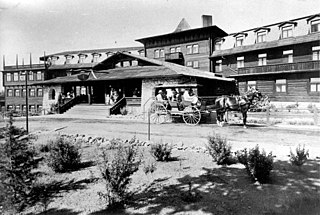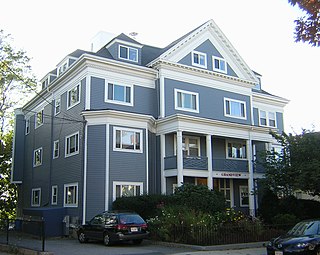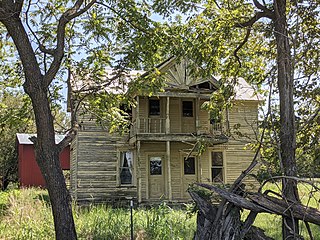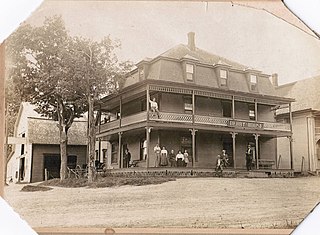
The Lake McDonald Lodge is a historic lodge located within Glacier National Park, on the southeast shore of Lake McDonald. The lodge is a 3+1⁄2-story structure built in 1913 based on Kirtland Cutter's design. The foundation and first floor walls are built of stone, with a wood-frame superstructure. The lobby is a large, open space that extends to the third story. It has a massive fireplace and a concrete floor scored in a flagstone pattern, with messages in several Indian languages inscribed into it. The rustic lodge was designated a National Historic Landmark in 1987 as one of the nation's finest examples of large-scale Swiss chalet architecture. Lake McDonald Lodge is a member of Historic Hotels of America, the official program of the National Trust for Historic Preservation.

The El Tovar Hotel, also known simply as El Tovar, is a former Harvey House hotel situated directly on the south rim of the Grand Canyon in Arizona, United States.

Antlers Hotel is a historic hotel building in Lorain, Ohio, it was listed on the National Register of Historic Places November 30, 1982.

The Grand Canyon Lodge is a hotel and cabins complex at Bright Angel Point on the North Rim of the Grand Canyon. It was designed by Gilbert Stanley Underwood, who designed a number of other hotels in national parks for the Utah Parks Company and other concessioners. Built in 1927–28, the Grand Canyon Lodge resort complex consists of the Main Lodge building, 23 deluxe cabins, and 91 standard cabins, some of which were moved to the north rim campground in 1940. All guests are housed in cabins detached from the main lodge, which serves as a dining, concessions and service facility. Constructed of native Kaibab limestone and timber, the complex was designed to harmonize with its rocky and forested setting. The Grand Canyon Lodge complex is notable for its setting and rustic design, as well as its status as the only complete surviving lodge and cabin complex in the national parks.

Pahaska Tepee is William "Buffalo Bill" Cody's old hunting lodge and hotel in the U.S. state of Wyoming. It is located 50 miles (80 km) west of the town of Cody and two miles from the east entrance to Yellowstone National Park.

The Elms is a historic building at the junction of Lewiston and Elm Streets in Mechanic Falls, Maine. Built as a hotel in 1859 and used for a variety of purposes since then, the substantial building is a fine late expression of Greek Revival architecture, and a reminder of the town's heyday as an industrial center. It was listed on the National Register of Historic Places in 1985.

The Grandview is a historic apartment hotel at 82 Munroe Street in Somerville, Massachusetts. This type of building was not uncommon in the city at the time of its 1896 construction. This building affords commanding views of the Boston area from its site near the top of Prospect Hill, and has well-preserved Colonial Revival styling. The building was listed on the National Register of Historic Places in 1989.

The George Gabriel House is a historic house at 31 Lenox Street in Worcester, Massachusetts. Built in 1898, it is a significant local example of Colonial Revival architecture, and is one of the oldest houses in the city's Richmond Heights neighborhood. It was listed on the National Register of Historic Places in 1980.

Volcano House is the name of a series of historic hotels built at the edge of Kīlauea, within the grounds of Hawai'i Volcanoes National Park on the Island of Hawai'i. The original 1877 building is listed on the National Register of Historic Places and now houses the Volcano Art Center. The hotel in use today was built in 1941 and expanded in 1961.

Marlborough Building, also known as Marlborough Hotel, State Bank of Binghamton, State Hotel, and Marble Grill, is a historic building located at Binghamton in Broome County, New York. It was built in 1914 and is a three-story, five bay commercial building with a one-story addition and upper level stacked porches projecting from the rear. The front facade features a stepped parapet with a cast cartouche ornamented with foliage flanked by decorative cast stone foliage. It was built as a hotel and housed a bank on its first floor until 1930. From the 1940s to 1990s, the first floor was used for commercial establishments with apartments above.

H. (Henry) Neill Wilson was an architect with his father James Keys Wilson in Cincinnati, Ohio; on his own in Minneapolis, Minnesota; and for most of his career in Pittsfield, Massachusetts. The buildings he designed include the Rookwood Pottery building in Ohio and several massive summer cottages in Berkshire County, Massachusetts.

The Ann Street Historic District is a historic district encompassing part of Downtown Hartford in Hartford, Connecticut. A commercial and light industrial area, the district includes properties along Ann Uccello Street from Chapel Street south to Hicks Street. It also includes properties east of Ann Street fronting Pearl Street and Hicks Street to roughly Haynes Street, as well as properties west of Ann Uccello Street fronting Allyn and Asylum Streets to roughly a third of the block. The district's architecture typifies the city's development between about 1880 and 1930; it was listed on the National Register of Historic Places in 1983.

The Bacon Hotel, also known as the Sunrise Hotel, is a historic hotel building at the southeast corner of Railroad and Homestead Roads in Whitehall, Arkansas. It is a two-story wood-frame structure, with a cross-gable roof and a two-story porch extending across its front. The porch is supported by spindled wooden posts, and the front gable end features a large carved sunburst design. There are four guest rooms on each floor; those on the second level are accessed via outside stairs. The hotel was built in 1912, during the area's timber boom, and is one of the few surviving reminders of that period. It is also one of the state's finer railroad-era Folk Victorian hotels.

The Drewsville Mansion is a historic house on Old Cheshire Turnpike in the Drewsville village of Walpole, New Hampshire, United States. Built in 1880, it is a regionally rare example of vernacular Stick/Eastlake style architecture, located in an area that has predominantly even older buildings. The building was listed on the National Register of Historic Places in 1996.

Eagle Mountain House is a historic resort hotel at 179 Carter Notch Road in Jackson, New Hampshire. Built in 1916 and enlarged in 1929, it is one of the few surviving grand mountain resort hotels in the White Mountains of New Hampshire. The hotel is currently a member of Historic Hotels of America, the official program of the National Trust for Historic Preservation. It was listed on the National Register of Historic Places in 1990.

The Union Hotel is a historic hotel building at 254 Main Street in the Union village of Wakefield, New Hampshire. Built in 1855 and repeatedly enlarged, it is one of only two surviving 19th-century railroad hotels in the town. It was operated until 1960, and for many years housed the local VFW post. The building was listed on the National Register of Historic Places in 1989. It is now home to the Greater Wakefield Resource Center.

The Jenks Tavern, also known historically as the East Rupert Hotel and the Hotel G. Jenks, is a historic public accommodations house at the junction of West Dorset Road with Vermont Routes 315 and 30 in Rupert, Vermont. Built about 1807, it is a well-preserved example of an early 19th-century traveler's accommodation in southern Vermont. It was listed on the National Register of Historic Places in 1994. The building is now a private residence, the home of American playwright and author John Nassivera.

The Montgomery House is a historic travel accommodation on Vermont Route 118 in the center of Montgomery, Vermont. Built in 1803, it is one of the town's oldest buildings, and it served for many years as a social and civic center in the small community. It was listed on the National Register of Historic Places in 1992.

The Derby House Hotel is a historic former hotel building at Main and West Streets in Derby, Vermont. Erected in 1896, it was for many years an important element of the social and commercial life of the small community. Now converted into apartments, it was listed on the National Register of Historic Places in 1998.
The Quincy Hotel is a historic commercial building at 57 Depot Street in the Enosburg Falls village of Enosburgh, Vermont. Built about 1876 in the Second Empire style, it was restyled after a fire in the early 20th century to its present Colonial Revival appearance to a design by Vermont architect Lewis Newton. It was listed on the National Register of Historic Places in 2019 for its architectural significance.





















